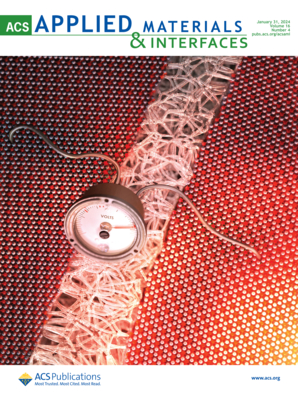Revealing Microstructured Surface Critical Heat Flux Degradation Mechanisms and Synergistic Pool Boiling Enhancement in Fluorinated Fluids
IF 8.3
2区 材料科学
Q1 MATERIALS SCIENCE, MULTIDISCIPLINARY
引用次数: 0
Abstract
Fluorinated dielectric fluids are widely utilized as heat transfer fluids for two-phase cooling of electronics, capitalizing on the fluids’ large latent heat release during boiling for efficient heat flux removal. Recent studies have optimized surface micro/nanostructures on aluminum alloy through chemical etching, achieving more than 2× enhancements in boiling heat transfer coefficients (HTCs) of these fluids compared to plain surfaces. However, these microengineered surfaces suffer from critical heat flux (CHF) reduction of nearly 40%, with the mechanisms driving this CHF reduction remaining unclear. Here, we investigate the mechanism resulting in the poor CHF of microstructured surfaces and develop a guideline to synergistically enhance the HTC and CHF of these surfaces. Immersion boiling tests in fluorinated and nonfluorinated fluids, coupled with wickability and elemental analysis, revealed that surface degeneration─caused by fluorine deposition forming C–F bonds with adventitious carbon─has minimal impact on CHF in fluorinated fluids. To further verify that surface degeneration is not responsible for CHF reduction, pool boiling experiments with cavity sizes from 1 to 5 μm identified the 5 μm cavity surface, AM-H(400)E(5), as achieving the highest HTC in both HFE-7100 and ethanol. However, CHF reductions of 30–50% were consistently observed, regardless of whether the surface transitioned to hydrophobicity or retained superhydrophilicity. Arising from this investigation, it is concluded that the increased nucleation site density on AM-H(400)E(5), which leads to the overcrowding of bubbles, is the primary cause of CHF reduction. To overcome these limitations, we devise a method of hierarchical addition of microstructures on macro-fins to simultaneously enhance HTC and CHF, creating a single-process two-tier hierarchical structure by leveraging on AM to fabricate the macrostructures. The two-tier macro/microstructure design has successfully enhanced HTC and CHF by 99 and 202.2%, respectively, compared to the best single-tier microstructured surface. This approach not only effectively delay undesirable vapor layer formation but also provides a robust guideline for enhancing boiling performance in other fluorinated fluids, including refrigerants R134a and R1234ze(E).

揭示微观结构表面临界热通量降解机制和协同池沸腾增强氟化流体
含氟介质流体被广泛用作电子设备两相冷却的传热流体,利用流体在沸腾过程中释放的大量潜热来有效地去除热流通量。最近的研究通过化学蚀刻优化了铝合金表面的微/纳米结构,与普通表面相比,这些流体的沸腾传热系数(HTCs)提高了2倍以上。然而,这些微工程表面的临界热通量(CHF)降低了近40%,导致CHF降低的机制尚不清楚。在这里,我们研究了导致微结构表面CHF差的机制,并制定了协同增强这些表面的HTC和CHF的指导方针。在含氟和非氟流体中进行浸没煮沸试验,再加上可溶性和元素分析,表明氟沉积与非固定碳形成C-F键引起的表面退化对含氟流体中的CHF影响最小。为了进一步验证表面退化不是CHF还原的原因,在1 ~ 5 μm空腔尺寸的池沸腾实验中,发现5 μm空腔表面AM-H(400)E(5)在HFE-7100和乙醇中都达到了最高的HTC。然而,无论表面是否转变为疏水性或保留超亲水性,都一致观察到CHF减少30-50%。由此得出结论,AM-H(400)E(5)上成核位点密度的增加,导致气泡过度拥挤,是CHF降低的主要原因。为了克服这些限制,我们设计了一种在宏鳍上分层添加微结构的方法,同时增强HTC和CHF,通过利用AM制造宏观结构创建单工艺两层分层结构。与最佳的单层微结构表面相比,双层宏观/微观结构设计成功地将HTC和CHF分别提高了99%和202.2%。这种方法不仅有效地延缓了不良蒸汽层的形成,而且还为提高其他含氟流体(包括制冷剂R134a和R1234ze(E))的沸腾性能提供了强有力的指导。
本文章由计算机程序翻译,如有差异,请以英文原文为准。
求助全文
约1分钟内获得全文
求助全文
来源期刊

ACS Applied Materials & Interfaces
工程技术-材料科学:综合
CiteScore
16.00
自引率
6.30%
发文量
4978
审稿时长
1.8 months
期刊介绍:
ACS Applied Materials & Interfaces is a leading interdisciplinary journal that brings together chemists, engineers, physicists, and biologists to explore the development and utilization of newly-discovered materials and interfacial processes for specific applications. Our journal has experienced remarkable growth since its establishment in 2009, both in terms of the number of articles published and the impact of the research showcased. We are proud to foster a truly global community, with the majority of published articles originating from outside the United States, reflecting the rapid growth of applied research worldwide.
 求助内容:
求助内容: 应助结果提醒方式:
应助结果提醒方式:


